Biometric Card Market Size
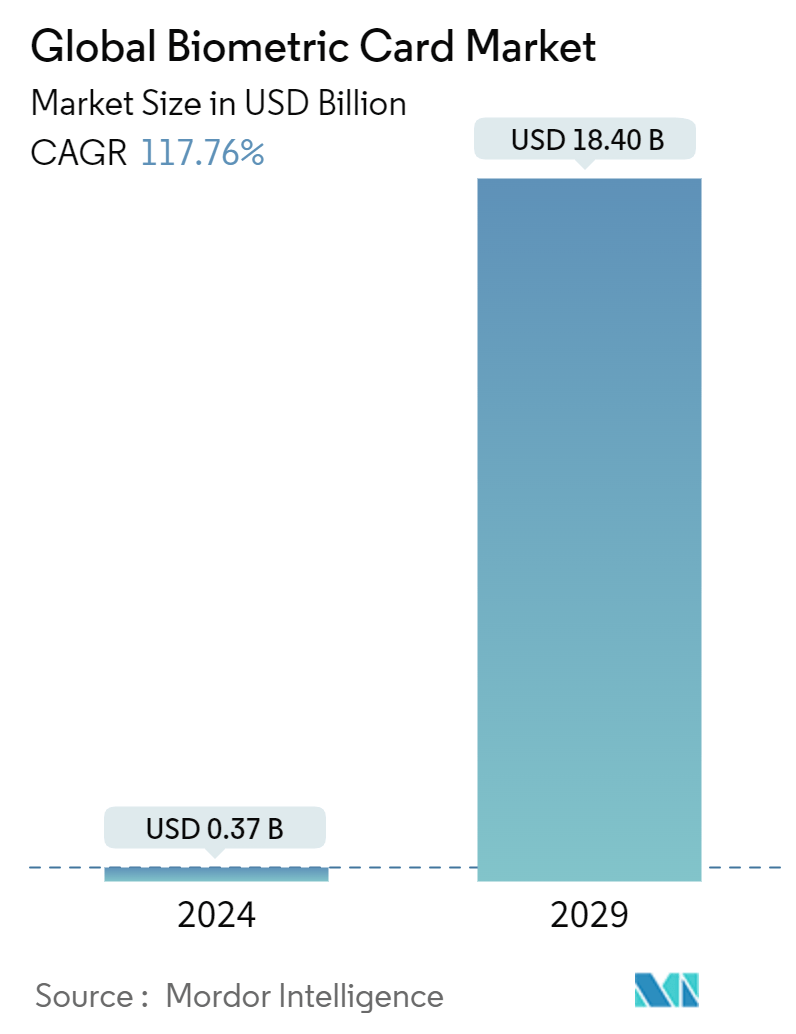
| Study Period | 2019 - 2029 |
| Market Size (2024) | USD 0.37 Billion |
| Market Size (2029) | USD 18.40 Billion |
| CAGR (2024 - 2029) | 117.76 % |
| Fastest Growing Market | Asia-Pacific |
| Largest Market | North America |
Major Players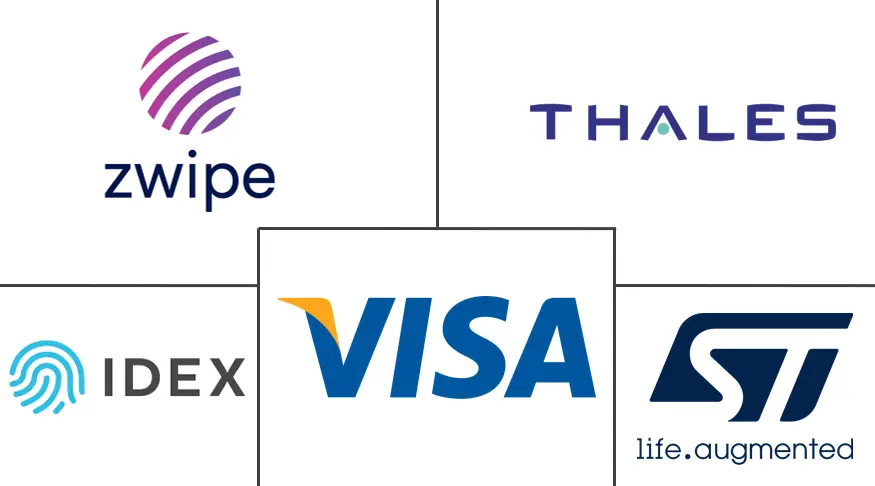
*Disclaimer: Major Players sorted in no particular order |
Biometric Card Market Analysis
The Global Biometric Card Market size is estimated at USD 0.37 billion in 2024, and is expected to reach USD 18.40 billion by 2029, growing at a CAGR of 117.76% during the forecast period (2024-2029).
- Biometric Authentication Revolutionizing Payment Security: The Biometric Card Market is witnessing significant growth as demand for secure and convenient payment methods rises. Biometric cards, incorporating fingerprint sensors or other biometric technologies, are revolutionizing the financial industry by addressing payment fraud concerns while improving user experience.
- Secure transactions: Biometric cards integrate fingerprint recognition with smart card technology to ensure secure payments.
- Ecosystem partnerships: A surge in collaborations among players in the ecosystem is driving the market forward.
- Major certifications: Mastercard, Visa, and China UnionPay are leading the way in certifying biometric card solutions.
- Financial Inclusion Driving Market Expansion: A key driver of the biometric card market is the demand from financial inclusion initiatives, particularly in emerging markets. Governments and financial institutions are adopting biometric technologies to integrate unbanked populations into the financial system, creating new growth opportunities.
- African initiatives: Mastercard and Paycode aim to enroll 30 million Africans in a biometric smart card financial inclusion program.
- Brazilian potential: Brazil shows high potential, with digital banks like Desty focusing on underserved populations.
- Global trials: Biometric card trials are ongoing in countries like Poland, Iraq, India, Mexico, Lebanon, and Egypt.
- Multi-Factor Authentication Boosting Market Growth: The growing adoption of multi-factor authentication (MFA) is a major factor fueling the biometric card market. As cybersecurity threats evolve, businesses and consumers are integrating MFA solutions that incorporate biometrics for enhanced security.
- Integration in MFA: Biometric authentication is becoming a key element of MFA systems.
- Healthcare adoption: The healthcare sector is embracing MFA to protect patient data.
- Ecommerce surge: The rise of mobile banking and ecommerce is increasing the demand for strong authentication.
- Competitive Landscape and Strategic Initiatives: The biometric card market is highly competitive, with strategic collaborations and innovations defining market dynamics. Leading players are focusing on technological advancements and certifications to strengthen their market positions.
- Thales Group leadership: Thales is at the forefront with over 20 biometric payment card projects.
- Partnerships for expansion: Companies like Zwipe, Idemia Group, and Fingerprint Cards AB are expanding their global reach by partnering with regional players.
- Innovation push: Major financial platforms are driving the adoption of secure, innovative technologies.
- Future Outlook and Market Potential: The future of the biometric card market looks promising, with emerging trends indicating sustained growth. The integration of biometrics with IoT and smart city initiatives is unlocking new opportunities beyond traditional payments.
- Multimodal biometrics: The market is evolving towards multimodal solutions, combining fingerprint, facial recognition, and hand geometry.
- Contactless payments: Contactless biometric payment cards are gaining popularity due to their security and convenience.
- Cryptocurrency integration: The use of biometric cards in cryptocurrency transactions is an emerging trend.
Biometric Card Market Trends
BFSI Segment: Dominating the Biometric Card Landscape
- Segment Growth and Market Share: The BFSI (Banking, Financial Services, and Insurance) sector is leading the biometric card market, with projected growth from USD 36.76 million in 2022 to USD 1.282 billion by 2029. The sector held a 66.10% market share in 2021, underscoring its dominance in driving market expansion.
- Combatting fraud: Financial institutions are focusing on enhanced security to mitigate rising card fraud.
- Pandemic-driven contactless payments: The global shift towards contactless payments has created fertile ground for biometric card adoption.
- MFA alignment: The increasing emphasis on MFA in financial transactions aligns perfectly with biometric cards.
- Micro Trends and Industry Initiatives: Collaborations between financial institutions and technology providers are driving innovations in the biometric card space. For example, Mastercard partnered with Jordan Kuwait Bank to launch a biometric payment card featuring an on-card fingerprint reader for PIN-free payments.
- Partnerships driving innovation: These collaborations highlight the push towards more secure and user-friendly payment methods.
- Digital renminbi trials: China Construction Bank’s partnership with IDEX Biometrics for digital renminbi experiments showcases the role of biometric cards in emerging digital currency ecosystems.
- Market Dynamics and Future Outlook: The BFSI sector's dominance is expected to continue, driven by increasing consumer demand for secure, seamless payment methods. As biometric technology matures and production costs decrease, widespread adoption is anticipated across banking services, further solidifying the sector’s role.
- Seamless upgrade path: Biometric cards provide financial institutions with a secure, scalable solution without disrupting existing infrastructure.
- Cost reduction and maturity: As production costs fall, widespread biometric card adoption across the BFSI sector is expected to surge.
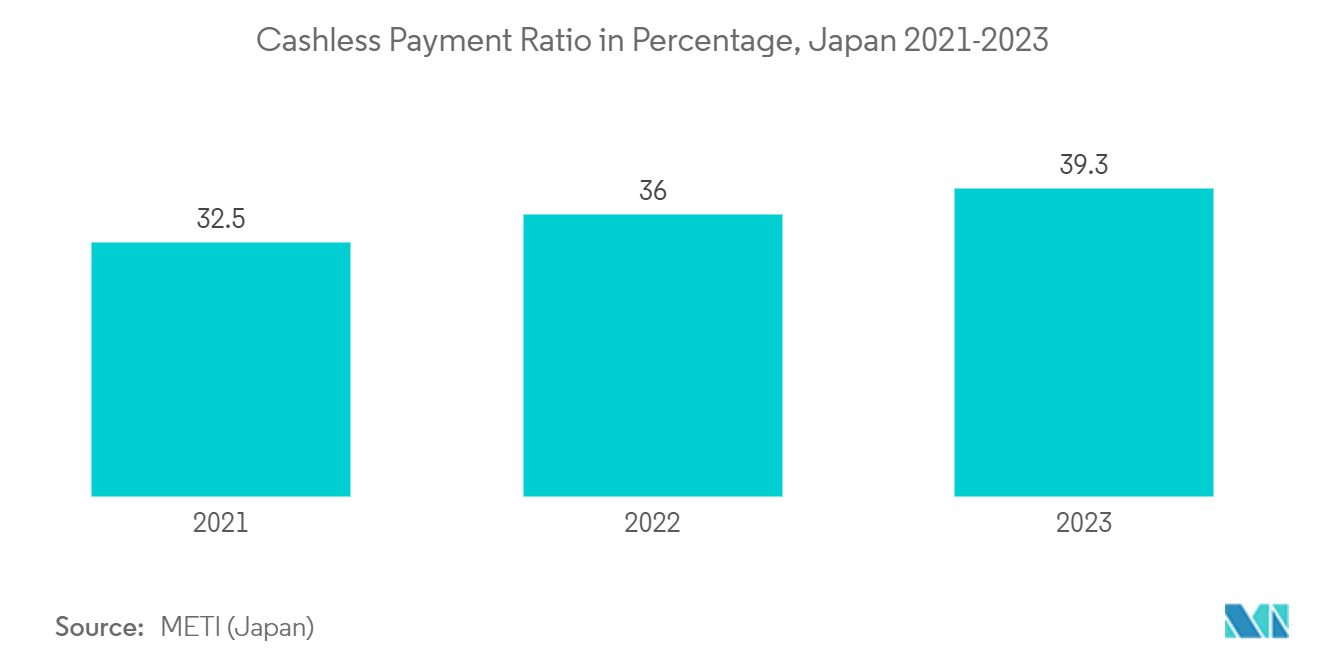
Asia-Pacific: The Fastest-Growing Regional Segment
- Market Growth Trajectory: The Asia-Pacific region is expected to experience the fastest growth in the biometric card market, expanding from USD 14.02 million in 2022 to USD 737.96 million by 2027, with a CAGR of 120.92%.
- Demographic trends: A growing middle class and increasing urbanization create a large addressable market for biometric card solutions.
- Government initiatives: Financial inclusion programs in India and China are creating an ideal environment for biometric card adoption.
- Micro Trends and Regional Initiatives: Asia-Pacific is witnessing numerous initiatives aimed at accelerating biometric card adoption. For instance, Fingerprint Cards AB has partnered with Transcorp to launch biometric cards in India, while MoriX in Japan is collaborating with Fingerprint Cards to develop secure payment methods.
- India's contactless push: India’s drive for contactless payments is accelerating biometric card adoption.
- Japan’s secure payment landscape: Japanese consumers are demanding secure, frictionless payment methods, boosting biometric card interest.
- Market Dynamics and Future Prospects: Asia-Pacific’s growth in the biometric card market is characterized by diverse market dynamics, ranging from tech-savvy economies like Japan to emerging markets like India and Indonesia.
- Diverse opportunities: The region’s diversity offers unique challenges but also substantial opportunities for biometric card players.
- Broader sectoral adoption: Beyond BFSI, sectors such as healthcare and government ID programs are expected to drive further growth.
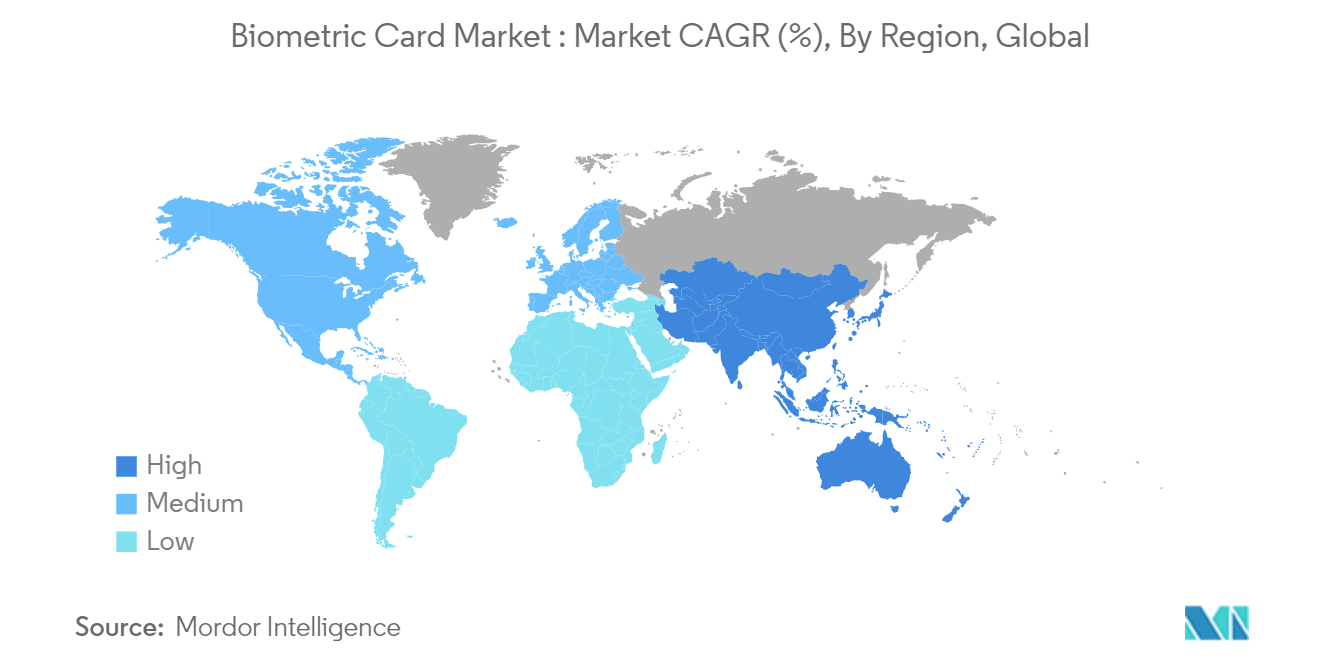
Biometric Card Industry Overview
Market Dominated by Global Technology Conglomerates
The Global Biometric Card Market is led by major technology conglomerates and specialized biometric solution providers. Key players, including Thales Group, IDEMIA Group, and Mastercard, dominate the market with their technological prowess and global reach.
Consolidated market: These companies command significant market share due to their technological expertise.
Global reach: Their presence in multiple regions strengthens their market positions.
Innovation and Partnerships Drive Market Leadership:
Innovation and strategic partnerships are critical for maintaining market leadership. Companies like Fingerprint Cards AB and IDEX Biometrics ASA lead in the development of advanced biometric sensors and software solutions. Collaborations with major payment networks are essential for gaining market certification.
Technological leadership: These companies invest heavily in R&D to develop next-generation biometric solutions.
Strategic alliances: Partnerships with financial institutions enable deep market penetration and certification compliance.
Factors for Future Success in the Market: Several factors are crucial for future success in the biometric card market. Reducing production costs, ensuring compliance with regulations like GDPR, and expanding into emerging markets are vital for growth.
Cost efficiency: Lowering production costs from USD 20 to USD 5 per card is a key goal.
Security and compliance: Enhanced security features and regulatory compliance are essential for market success.
Emerging market opportunities: Partnerships with local institutions in emerging markets provide new growth avenues.
Biometric Card Market Leaders
-
Zwipe AS
-
Thales Group
-
IDEX Biometrics ASA
-
STMicroelectronics NV
-
Visa Inc
*Disclaimer: Major Players sorted in no particular order
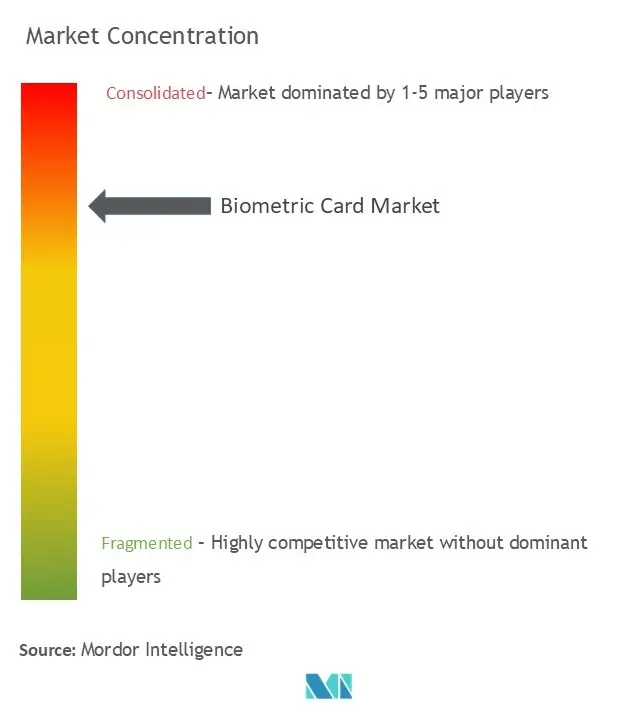
Biometric Card Market News
- August 2024 - IDEX Biometrics introduced biometric payment cards in India. The cards perform biometric authentication directly on the card, requiring no changes to existing payment terminals and infrastructure.
- July 2024 - Fingerprint Cards AB and IN Groupe launched a secure component solution for contactless biometric payment cards. The cards use Fingerprints' T-Shape® sensor module and software platform, based on STMicroelectronics STPay-Topaz-Bio solution.
- June 2024 - Zwipe and Seriline signed a distribution agreement for biometric access cards in the Nordic Region. Zwipe Access cards integrate biometric authentication into standard ID cards for access control solutions.
- March 2024 - Zwipe partnered with SCAP to introduce biometric access cards to SCAP's customers in France. Zwipe Access cards store the cardholder's encrypted fingerprint template within the card's smart chip for biometric verification."
Biometric Card Market Report - Table of Contents
1. INTRODUCTION
- 1.1 Study Assumptions and Market Definition
- 1.2 Scope of the Study
2. RESEARCH METHODOLOGY
3. EXECUTIVE SUMMARY
4. MARKET INSIGHTS
- 4.1 Market Overview
-
4.2 Industry Attractiveness - Porter's Five Forces Analysis
- 4.2.1 Bargaining Power of Suppliers
- 4.2.2 Bargaining Power of Buyers
- 4.2.3 Threat of New Entrants
- 4.2.4 Threat of Substitutes
- 4.2.5 Intensity of Competitive Rivalry
- 4.3 Assessment of Impact of COVID-19 on the Market
- 4.4 Industry Ecosystem Analysis
- 4.5 Evolution of Biometric Cards
5. MARKET DYNAMICS
-
5.1 Market Drivers
- 5.1.1 Growing Demand from Financial Inclusion-based Initiatives in Emerging Countries
- 5.1.2 Move Toward Multi-factor Authentication Bodes Well for Market Growth
- 5.1.3 Financial Inclusion Driving Market Expansion
- 5.1.4 Biometric Authentication Revolutionizing Payment Security is Driving The Market Growth
-
5.2 Market Challenges
- 5.2.1 Strong Competition from Non-card Biometric Devices
- 5.2.2 Higher Implementation Costs
6. MARKET SEGMENTATION
-
6.1 By Application
- 6.1.1 Payments
- 6.1.2 Access Control
- 6.1.3 Government ID and Financial Inclusion
- 6.1.4 Other Applications
-
6.2 By End-User Vertical
- 6.2.1 BFSI
- 6.2.2 Retail
- 6.2.3 Government
- 6.2.4 Healthcare
- 6.2.5 Commercial Entities
- 6.2.6 Other End-user Verticals
-
6.3 By Geography
- 6.3.1 North America
- 6.3.2 Europe
- 6.3.3 Asia Pacific
- 6.3.4 Rest of the World
7. COMPETITIVE LANDSCAPE
-
7.1 Company Profiles*
- 7.1.1 Zwipe AS
- 7.1.2 Thales Group
- 7.1.3 IDEX Biometrics ASA
- 7.1.4 ST Microelectronics NV
- 7.1.5 Visa Inc.
- 7.1.6 Seshaasai Business Forms (P) Ltd
- 7.1.7 IDEMIA Group
- 7.1.8 Goldpac Fintech
- 7.1.9 Mastercard Incorporated
- 7.1.10 Fingerprint Cards AB
- 7.1.11 Ethernom Inc.
- 7.1.12 Samsung’s System LSI Business
- 7.1.13 Shanghai Fudan Microelectronics Group Co. Ltd
8. INVESTMENT ANALYSIS
9. FUTURE OUTLOOK
10. MARKET OPPORTUNITY ANALYSIS
** Subject To AvailablityBiometric Card Industry Segmentation
A biometric card combines embedded chip technology with fingerprint authentication technologies. It is used to verify a cardholder’s identity for in-store purchases.
The biometric card market is segmented by application (payments, access control, government id, financial inclusion), end-user vertical (BFSI, retail, government, healthcare, commercial entities), and geography (North America, Europe, Asia-Pacific, rest of the World). The Market Sizes and Forecasts are Provided in Terms of Value (USD) for all the Above Segments.
| By Application | Payments |
| Access Control | |
| Government ID and Financial Inclusion | |
| Other Applications | |
| By End-User Vertical | BFSI |
| Retail | |
| Government | |
| Healthcare | |
| Commercial Entities | |
| Other End-user Verticals | |
| By Geography | North America |
| Europe | |
| Asia Pacific | |
| Rest of the World |
Biometric Card Market Research FAQs
How big is the Global Biometric Card Market?
The Global Biometric Card Market size is expected to reach USD 0.37 billion in 2024 and grow at a CAGR of 117.76% to reach USD 18.40 billion by 2029.
What is the current Global Biometric Card Market size?
In 2024, the Global Biometric Card Market size is expected to reach USD 0.37 billion.
Who are the key players in Global Biometric Card Market?
Zwipe AS, Thales Group, IDEX Biometrics ASA, STMicroelectronics NV and Visa Inc are the major companies operating in the Global Biometric Card Market.
Which is the fastest growing region in Global Biometric Card Market?
Asia-Pacific is estimated to grow at the highest CAGR over the forecast period (2024-2029).
Which region has the biggest share in Global Biometric Card Market?
In 2024, the North America accounts for the largest market share in Global Biometric Card Market.
What years does this Global Biometric Card Market cover, and what was the market size in 2023?
In 2023, the Global Biometric Card Market size was estimated at USD -0.07 billion. The report covers the Global Biometric Card Market historical market size for years: 2019, 2020, 2021, 2022 and 2023. The report also forecasts the Global Biometric Card Market size for years: 2024, 2025, 2026, 2027, 2028 and 2029.
Biometric Card Industry Report
Biometric Card Market Research
Our industry research offers a comprehensive analysis of the biometric card market, focusing on key growth factors, technological advancements, and adoption trends. This report covers critical aspects such as biometric card technology development, innovations in fingerprint biometric cards, and the surge in demand for contactless biometric cards. It also evaluates emerging market opportunities, providing stakeholders with actionable insights on how biometric payment cards are revolutionizing security in the financial sector. All findings and projections are compiled in an easy-to-read report pdf format, ideal for decision-makers seeking thorough market analysis.
The report explores current biometric card market trends, identifying key drivers of biometric card adoption, such as evolving consumer security preferences and the expansion of biometric technology into various sectors. Additionally, it highlights significant innovations in biometric card applications, offering a clear view of future market potential. Stakeholders benefit from detailed industry reports that include market forecasts, biometric card industry growth, and biometric card market demand. Through expert-driven insights, this analysis equips businesses with the information needed to navigate the rapidly evolving biometric landscape.



